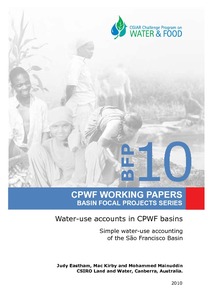Resource information
This paper applies the principles of water-use accounts, developed in the first of the
series, to the São Francisco basin in South America. The São Francisco Basin lies wholly
within Brazil. There are several major dams and wetlands in the Basin.
Net runoff is about 16% of total precipitation. Grassland is the most extensive land use,
covering 59% of the Basin and uses 48% of the water. Rainfed agriculture covers 23%
of the basin, but uses 14% of the water in the Basin. Forest and woodland cover 16% of
the basin and use about 21% of the precipitation. Grassland covers much of the upper
part of the Basin, consuming about 21% of the precipitation. Irrigated agriculture covers
just about 2% of the Basin and uses about 2% of the water.
Climate change, using an assumed change in increase in rainfall and evapotranspiration
distribution, reduces flow at Juazeiro and storage in the Sobradinho reservoir. The
transfer of water from the São Francisco Basin to the northeast of Brazil reduces annual
average flow by 6% only. However, the combined impact of the planned diversions and
drying due to climate change would be greater again.
Keywords: Water use accounts, São Francisco basin, top-down modeling, basin water
use.


